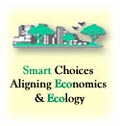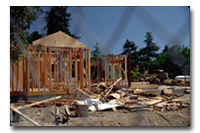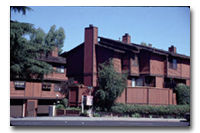|
|
|
Syndicated Features Archive Sustainable Building By Katherine Thornberry The latest buzzword being heard in design and construction circles across the U.S. is "sustainability." Sustainable design and building is generally defined as using products and procedures that make environmentally sensitive use of land, minimize waste, maximize resource and energy efficiency, conserve water, and do not pollute indoor air. How buildings are designed and built and the way we use them has a major impact on the environment. This awareness began with the energy crisis of the 70s and gave rise to the many changes in how to seal and insulate buildings, and the many other energy-efficient innovations we've seen since then. The impact on the environment may be even greater today. "The modern buildings we live and work in rival such well known polluters as cars and
Some of their key findings include: 55 percent of the wood cut for non-fuel sources is for construction; 40 percent of the world's materials and energy is used by buildings; and 30 percent of newly built or renovated buildings suffer from "sick building syndrome," exposing occupants to stale or mold-chemical-laden air. But as severe as these problems are, says the report, the building techniques and technology exist to eliminate much of the damage that buildings do and still maintain the building amenities that we've come to expect. The result is healthy building, lower utility costs and more desirable living and work spaces. The building and design industries recognize the issue's importance. In its 1996 Annual Convention Survey which looks at housing expectations and issues facing the industry, the National Association of Home Builders (NAHB) found that in the western U.S., 30 percent of the respondents felt the environment was extremely important. Another 61 percent felt it was moderately or very important. The industry is responding to shift toward green building by using practices that address myriad issues under the umbrella of sustainability, taking an integrated look, when possible, at a construction project from siting all the way through to how a building can be used most efficiently once it's occupied. "(Sustainability) is in line with architectural thinking. It's stepping back and looking at problems broadly, looking outside the box, rather than looking at why isn't this building working after the fact... There's a notion of being more holistic which is a reaction to mistakes we've made in the past. We realize it can be more effective if you solve problems at the design stage," said Christopher Gribbs of the American Institute of Architects (AIA). The AIA has had a Committee on the Environment since the early 90s and has done several intensive workshops across the U.S. on green design and construction, in addition to producing reference materials on the subject. The AIA has an integrated approach - environmental design charettes - that
The NAHB also has several committees looking at sustainable development and healthy and environmentally-friendly materials. Sustainability is not just a buzzword or passing fad, say design and building professionals. It's here to stay. The building industry, which typically feels hampered by environmental regulations, is embracing sustainability because it's realizing that building green is good for business. "It's not just a fad anymore...Where there are proven economic benefits, for example, waste prevention from demolition through construction, there's proven financial returns," said Lynn N. Simon, a San Francisco AIA board member and member of the U.S. Green Building Council. Sustainable design is the biggest change in design and construction in the past decade, according to Linda Stevenin, principal of the Mountain View-based CAS Architects. There's greater use of recycled materials in new construction and recycling of material from job sites, for example, and Ms. Stevenin said that major corporations like Hewlett-Packard look for such solutions in their building projects. Aspect Telecommunications worked with San Jose-based Lyncon Inc. General Contractors on the renovation and expansion of its building complex off Fox Drive in North San Jose, including in its job specifications language to ensure that the contractor work with the architect and tenant to identify reuse potential prior to demolition. For Aspect, the sustainability concept was a natural because the corporate culture is very "green" according to Vicki Holman, Aspect's project manager on the job. Ms. Holman said that they started at the design stage, for example, considering the copy/mail/fax areas with recycling in mind. Materials like carpeting, ceramic tile, doors, and office furniture were given to local non-profit Design Response and Resource Connections. Scrap metal such as wiring, light fixtures and metal studs and wood pallets were recycled. The client was then issued a credit for the savings realized from such recycling efforts. "It's necessary to include language on sustainable building in the job specs," said Paul Hauser, Lyncon's vice president. "It takes the effort of the architect, client and general contractor to make it work." "It's intriguing because of the opportunity for benefits in each of those areas of concern. It's getting attention now because of the potential for significant economic benefits to the project and the end user," said Mr. Campbell. The economic returns include: energy and water conservation savings; capital cost reduction by reducing the plant mechanical system needs; increased durability which lowers maintenance and operating costs; and the greatest impact, increased effectiveness and productivity of the work force who work better in a healthy, comfortable environment. Mr. Campbell cited examples including Verifone, which saw a 40 percent improvement in attendance after completion of a remodel which incorporated green building principles, and Lockheed, which saw a 15 percent productivity increase thanks to a green remodel that included among other features an indoor atrium. Resources continue to surface as well to support the growing interest in green building. A bi-monthly publication called Environmental Building News (EBN) sprung up in late 1992 in response to the growing demand by industry professionals for reliable and up to date information on environmental building trends and current research. "It's fairly recent to look at all environmental issues related to building as a package, looking at the design as a whole and making the building more green. Each has been looked at separately for some time, such as energy efficiency, but in the 90s that expanded to include the broader environmental spectrum," said Nadau Malin, EBN's managing editor. Mr. Malin's role keeps him and EBN on the cutting edge of green building trends, which he said vary by region. He notes that dryer areas are looking at water efficient landscaping and rain water catchment systems. Colder regions continue to focus on energy efficiency, but are now looking at indoor air quality as well. A trend gaining attention in California and the west coast is using locally available and/or produced resources as opposed to importing. There's even a digital news digest - GreenClips - that summarizes recent articles on green architecture and related government and business issues, and covers green building strategies, case studies, new technologies and products, legislation, and more. It's produced and distributed online and via e-mail by architectural researcher and consultant Christine Hammer of the San Francisco-based Sustainable Design Resources. Katherine Thornberry is a San Jose based business, technology, and real estate writer. Her local government career includes several years working as part of the City of San Jose's Environmental Services staff. She has written for the San Jose Mercury News, the San Jose Business Journal, and others.
Site Directory | EcoIQ Magazine Archive | Link Center © Copyright 1997-2018 EcoIQ |













